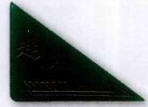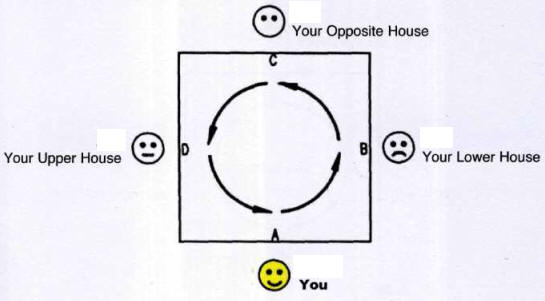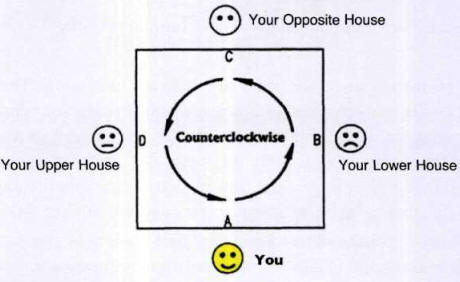
The game of mah jongg
Jeux
Mah-Jongg
A game of mah jongg calls for four players seated at a square table, one on each side. Each player draws a hand of 13 tiles from the center of the table, and the ritual of tile exchange begins. One at a time, the players draw a new tile from the table or pick up a matching tile discarded by another player.
At the same time, players discard their unmatched tiles, seeking with each move to create a matched hand. Thus, the initial objective of each player is to match all the tiles in his or her hand before the other players do. The first player to do so wins the game.
The second objective is to assemble the highest-scoring hand at the table. The score, which is based on the probability of achieving a certain combination of tiles, is calculated by totaling the winning points of all the tiles in the hand.
In general, the lower the probability of achieving a certain combination, the
higher the score awarded. Of course, the
converse is true as well.
Mah
jongg is a game both of chance and risk as there is not one without the other.
Yet another factor is time. A higher-scoring hand takes longer to assemble. In
other words, the longer you delay putting together your hand, the greater is
your risk of losing the game to a player who may beat you to it.
Mah jongg is also a game of strategy. You must cultivate a keen eye for the pattern of discards and matching of tiles by your opponents. From this observation, you must try to predict what patterns the other players are likely to be assembling.
On the one hand, you try to utilize your opponents' discards to match your tiles, thus maximizing your chance of winning. On the other hand, you try to prevent your opponents from matching their tiles with your discards.
Arguably, the most intriguing part of the game lies in the decision making. You will constantly wonder whether to risk discarding a tile (thus giving your opponents a chance of matching theirs) to increase your chance of assembling a higher-scoring hand, or to hold on to your hand for a safe win, thereby forgoing the opportunity of a better score.
Remorse after a hand is common. For some, it is the regret of not having had the boldness to go for a big hand. For others, it is the recklessly ambitious pursuit of a big hand, only to have another player reveal a matched hand first.
Most observers believe that a player's behavior reflects his or her true personality. The magic of mah jongg is the feeling of exhilaration that comes from winning a hand as well as from knowing that a wrong move or the loss of a hand can still lead to victory eventually.
A player always sees another chance in the next hand. He or she knows that as the game unfolds, many new opportunities will present themselves, along with an endless stream of hopes and expectations, a situation rarely, if ever, encountered in real life.
The Tiles
Mah jongg tiles are small rectangular blocks of
plastic, with symbols engraved on the face of each one. In the past, the tiles
were made of ivory, animal bone, or bamboo. The sizes vary and can range from
approximately V2 inch thick by 3A inch wide by 1 inch tall to 1 inch thick by
1.5 inches wide by 2 inches tall.

A standard mah jongg set contains 136 tiles, divided into two major groups:
the Common (or Number) tiles and the Honor tiles. In addition, there are 8
optional Flower tiles, making a total of 144 tiles.
(1) The Common tiles
consist of three suits, each composed of four sets of tiles. Each set is
numbered one through nine.
The Circle Tiles (Tung Jee)

The Bamboo Tiles (Sok Jee)
Note: The No. 1
Bamboo tile is represented by the picture of a sparrow.

The Character Tiles (Man Jee)

(2) The Honor tiles consist of the Dragons and the Winds: (Fan Jee) There are three Dragons, Red, Green, and White, with four tiles each.
Red (Chung), Green (Fat), White (Bak)

There are four Winds, East, South, West, and North, with four tiles each.
East (Dong), South (Nam), West (Say), North (Buk)

(3) An optional group of 8 Flower tiles exists: Spring, Summer, Autumn, Winter, Plum, Orchid, Chrysanthemum, and Bamboo (no relationship to the Bamboo tiles in the Common group). (Far Pai)

Accessories
Dice
Dice are used for the allocation of seats, for the
designation of the First Dealer, and for breaking the wall of tiles for each
game. A set of two or three dice may be used, although beginners are advised to
use only two dice for all purposes. This is because the highest sum of dots from
three dice is 18, which exceeds the number of tile stacks in each section of the
walls, thus complicating the breaking of the walls.
First Dealer Indicator (Hei Jong)

The indicator is displayed at the left-hand corner of the First Dealer to remind the players to change the Wind in each round of the game.
Dealer and Wind Indicator (Jong)

The Indicator, which is used to designate the Dealer in each hand of the game, can be any one of many different designs. When a hand is finished, the Indicator is passed to the next Dealer. The Indicator is also used to indicate the Wind of the round. Accordingly, the Wind sign shown on the Indicator is also changed after each round.
A Hand of Tiles

A playing hand consists of 13 tiles. A winning hand consists of four matched sets of 3 tiles each and one pair called the Eyes of the hand. A matched set can be a Sequence or a Triplet. Thus, a player is always waiting for either a 14th tile that completes the last matched set or the Eyes to declare a win.
A sequence is composed of any three consecutive numbers of the same suit. (Sunjee)

A Triplet is composed of any three identical tiles of the same suit. (Hak Jee)

The Eyes can be any 2 identical tiles. (Ngan, Jiang)

A Few Examples of Winning Hands
A. Chicken
Hand: Consists of Sequences and Triplets of more than one suit. It is the
easiest way to assemble a winning hand.

B. Common Hand: Consists of only Sequences of more than one suit.

C. All Triplets Hand: Consists of only Triplets of more than one suit.

D. Mixed One-Suit Hand: Combines tiles in one suit and Honor tiles

E. Pure One-Suit Hand: Consists of tiles in only one suit

F. All Honor Tiles Hand: Consists of Honor tiles only.

G. 13-Terminal Tile Hand: Consists of one each of numbers one and nine of each Common suit and one each of the Honor tiles, plus one additional tile that matches any of the tiles in the hand

Players and Their Respective Playing Positions
A game of mah jongg requires four players. The players sit around a square
table, and the game proceeds in a counterclockwise direction. Each player calls
the player on his or her right the Lower House, the player on his or her left
the Upper House, and the player sitting across the table the Opposite House.

There is a Dealer for each hand of the game. His or her sole function is to commence the game by casting the dice and breaking the walls of tiles. During each and every hand of the game, the Dealer is called the East House. His or her Lower House is the South House, the Opposite House is the West House, and the Upper House is the North House.

Playing Directions The allocation of each player's seat, the designation of the First Dealer, and the playing of the game proceed in a counterclockwise direction. The order in which the players take turns to retrieve a tile and discard a tile also travels counterclockwise.
As has been pointed out, each player calls the player on his or her right the Lower House, the player in front of him or her the Opposite House, and the player to the left the Upper House. The breaking of the walls and the drawing of tiles from the wall proceed in a clockwise direction, however.

Retrieving and discarding tiles

Breaking of the walls and drawing of tiles
Different Rules of Mahjongg Game It is natural that a game played by many ethnic groups for centuries would have developed variations and even very different sets of rules. Today, the most commonly known rules of play are:
(1) The Old Rules, also known as the 13—tile Cantonese Game
(2) The New Rules, also known as the Shanghai Game
(3) The 12-TileGame
(4) The 16-Tile Game, also known as the Taiwanese Game In all of these games, the rules are basically the same.
The major difference lies in the method of scoring, which changes according to the many variations in the combinations of tiles and the sets in a winning hand. Minor differences include the method of seat arrangement, the selection of the First Dealer, the construction of the wall, the discarding of tiles, the displaying of the revealed sequence, terminology, and so on.
This site instructions for all four versions of the game. The Cantonese Game (Old Rules) is considered the most practical for beginners to learn because of its simpler scoring system. Of the four games, the most complicated is the Shanghai Game, due to its many combinations.
